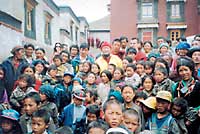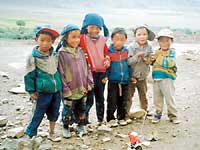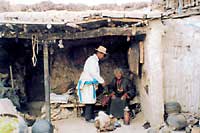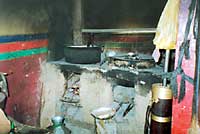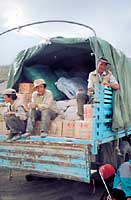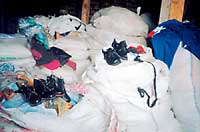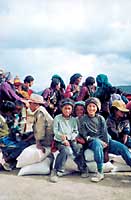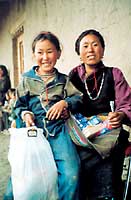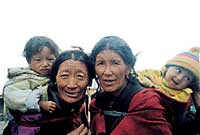|
|
||||
|
Hundreds of kilometres covered to
bring aid to the children of nine villages. |
||||
|
It was during my second trip to Tibet in the summer of 1988, that I found myself on the banks of the Nam-Tso lake, a huge salt lake, when suddenly a wild storm unleashed. Impossible to sleep in the tents prepared for us by our guide, the group requested refuge in a nearby village. Inside the house, without windows, was dark with only the dim illumination of a butter lamp; in the centre of the room there was a miserable hearth, and some straw mattresses on the floor acting as beds. Despite this poverty, directly beneath the lamp I noticed the presence of a few sacred images. In one corner some sacks of tsampa, barley flour, were stacked: the only stock of food for the long winter months during which the snow and icy cold would completely isolate them from the rest of the world. I felt pangs of sadness in my heart, and deeply ashamed that we had arrived here in the beautiful jeep of the travel agency, with both a guide and cook at our service, almost «spying» on the suffering of these people. In my first trips to the east, tired of materialistic western values, I had felt fascinated and deeply attracted to the profound spirituality of those places. But now, all of a sudden, my eyes had been opened, I was finally seeing how those people desperately clung to life on the 4500 metre high Tibetan plains, living without most basic human necessities. Where could these children, ragged and without shoes, be cured if they got sick? How could they hope to receive an education, without a school or any means of transport? What would they do if those few sacks of flour were not enough to see them through the winter? Where could they go to find comfort and express their faith, maybe to the destroyed monasteries? How could we, in conclusion, hope that these people survive, ethnically and culturally, without help? For the first time, I began to feel that between the east and west there was maybe the need for an exchange - spirituality in exchange for material help: for both sides a vital exchange to save the body and mind. Inside me was born a strong desire to bring in someway help to this population, as I believe happens to most people who visit Tibet, but which is still until this day almost completely excluded from international aid. My dream was realised a few years later, thanks to meeting Lama Gangchen. His work had exactly this scope, giving to the west the treasures of the Tibetan spiritual tradition, and on the other side, in the east, building schools, healing centres, monasteries, bringing aid to - children, elderly, monks and the sick - the poorest and most forgotten people. «Help in Action», the Association founded by him, is called Kiurok Tsochun in Tibetan, which actually means: «help for the poorest and alone». After initiating the adoptions at a distance project in the Tibetan refugee camps in South India, and later in Nepal, it was not so easy to start the project in Tibet. Still today, I am convinced that the fact that we are able to work there, where help is more urgently needed but also more difficult to carry out, is a kind of miracle, due only to the courage and compassion of Lama Gangchen. During a trip to Tibet in the summer of 1997, in his company, I timidly and almost secretly took the first 20 photos of children in Gangchen Village. The children stared at me with huge questioning eyes: for what purpose could the card with their names and their parents name possibly serve? The local authorities also watched and followed us, even to them it was not clear what we were doing. This summer, just three years later, we arrived in Tibet with aid for children of nine villages in the area of Gangchen, which is situated to the west of Shigatse, the second largest city in Tibet. Still today, the local government authorities and police accompany us to all the villages, following our work, scrupulously registering all the aid given: but in these years they have also verified that our help is exclusively of a humanitarian nature, and so they leave us to work, in fact I would say that they are helpful in the long and complex operations. In the Tibetan villages of this region there is no electricity nor sufficient water for domestic or agricultural use, no heating during the wnter months in which the temperatures drop to -20° or more; the winding roads which connect them to the rest of the world are often broken, there is no post and not even a shop, there is a lack of medical structures and those that do exist are too far away to be reached by the sick, there is no public transport and very few private vehicles. Life here is one of survival, based upon the poor harvests collected during the summer months from a dry and stoney earth - barley, wheat, legumes - and for the lucky ones maybe a goat, sheep or yak. Wool is spun and woven at home, and for most to have in the house a few yuan - the chinese currency which is in circulation - is a rare event, because the families have no income, they simply barter for necessary items within the village compound. To have available that minimal amount of money to buy books, pens and exercise books for the children or to buy clothes and warm shoes, to be able to depend upon a stock of food sufficient for the long winter months or to be able to reach a doctor and buy medicines, for them is an insuperable difficulty: and so the children simply do not go to school, people die from sicknesses which can be cured, and the diet is always inadequate and seriously unbalanced. The children confront the harshness of winter, at this altitude, with shoes made from rags on their feet, for a few there is the luxury of canvas gym shoes which cost the least in the market of Shigatse, but which many still cannot afford. They wear patched up clothes and rags; very rarely does anyone have a change of clothes, something extra to what they are wearing, so they can change. Despite all this the children are happy, with beautiful smiles, because they belong to a population that has a strong and ancient cultural and spiritual identity, which gives to them inner strength and optimism: an identity which is at great risk, because amongst the monasteries, traditionally the heart of the villages and of all the spiritual, artistic, medical and cultural traditions of Tibet, very few have remained in tact - even if the government has in the past few years carried out a plan to restore and rebuild the bigger and well known monasteries such as Ganden. The village schools, when they exist, are extremely poor: often there is just a small building, a single room with an earth floor, without desks, without heating, without materials for reading and writing. Often the children - those who have the fortune to attend - sit on the floor and use, instead of exercise books which they are unable to afford, wooden boards. These boards are also extremely precious because wood is very scarce here. The wages paid to teachers are very low, and they are not supplied with any kind of support or educational materials. The teacher in Ten, a small village near Gangchen, candidly told us that the only subject that he was capable of teaching was Tibetan: this is already a lot for the 40 children to be able to learn how to read and write their own language. Adding only sometimes a little Chinese, that which he knows, and occasionally some very basic mathematics. The houses in the villages are very poor, built from mud bricks dried in the sun; often there are no windows, to stop the winter cold from entering, and the only opening other than the entrance door is a hole in the ceiling from which exists the smoke from the hearth; in fact sometimes the children we meet are completely black from the soot. In this area trees are very rare, therefore to light fires the children collect twigs or yak dung, which is left to dry in the sun and then stored for the long winter months. Animals, for those who have them, live in the courtyard of the house, which is often covered with sewage, or in winter in a small room from where their heat contributes a little bit to heating the living space. In general, the whole family sleeps in the same room next to the hearth. The sense of family is very strong here, and so the elderly are deeply respected and always stay within the family, even if this creates difficulties due to the extra care they need, also from a medical point of view. It has often happened that we have met families who, regardless of their poverty, have taken in children that have been left alone, sometimes children of a relative but also of other inhabitants of the village. Stacked in a corner of the house are sacks of tsampa, barley flour, which when mixed with tea, salt and yak butter is the base of the Tibetan diet, sometimes with this a little piece of dried meat. One of the principal problems here is water: in Tibet, above all in this area, it rains little and the Himalayan mountains with their impetuous torrents are from away from these villages. Therefore water is scarce, insufficient not only for domestic and hygeinic purposes, but also for irrigation and therefore to ensure an adequate harvest. This year to help the children of nine villages in the province of Shigatse (Gangchen, Ten, Singma, Dakshuk, Ney, Dhonnang, Nepu, Gyedin, plus the city of Shigatse), we travelled hundreds of kilometres by jeep to reach them, followed by lorries loaded with gifts. In every village we were always welcomed by the village head, the children and all the other villagers with great festivities; our arrival has become for them an important event and awaited with joy. This year, with thanks to a greater number of westerners who sent donations for the adoption at a distance project, we were able to buy much more in the Lhasa and Shigatse markets; we were particularly pleased to purchase 850 pairs of children’s shoes: real shoes, in leather with rubber soles. For many of the children it was obvious that these were the first real shoes of their life, and a gift which filled them with genuine happiness. We also bought warm sweaters, shirts, trousers, pens, ink, pencils, erasers, and then for every family sacks of rice and flour. One by one we called the children, using the list of the village leader: first all those who already have a sponsor, then those still without. We asked news of each child, from them and their parents, and to our great joy, many of the children sponsored last year had started to attend school. We distributed money and gifts, and delivered letters and photos from the sponsors. After, we photographed the children who are still without sponsors, but also to these we gave a little money and some gifts. To help us with translation, there was always Jamyang, a Tibetan monk, son of Lama Gangchen’s brother who since some years lives in Nepal: his help is so very precious and indispensable to «Help in Action» because here nobody speaks a word of English. Enrica Mazzi |
||||
|
|
||||

